IEP for Early Childhood: Analyzing Inclusive Education Strategies
VerifiedAdded on 2023/01/10
|13
|3455
|80
Homework Assignment
AI Summary
This assignment presents an Individual Education Plan (IEP) designed for a 4-year-old child with auditory processing issues in an early childhood learning center (ELC). The IEP meticulously outlines the child's strengths, including observation skills, patience, and social engagement, and interests such as imaginative play, sports, and art. It addresses the child's need for structured activities while also incorporating strategies to overcome challenges related to auditory processing. The plan details specific goals focused on developing social skills, improving decision-making, enhancing physical and language skills, and fostering imaginative abilities. The assignment includes observations of the child's behavior, planned experiences based on these observations, and evaluations of the effectiveness of these experiences. The proposed activities emphasize both solo and group engagement, incorporating visual aids, role-playing, and creative tasks to promote learning and inclusivity. The IEP also considers the importance of teacher and peer involvement to create a supportive and stimulating environment that caters to the child's unique needs and learning style.

Running head: INCLUSIVE EDUCATION IN EARLY CHILDHOOD
INCLUSIVE EDUCATION IN EARLY CHILDHOOD
Name of the Student
Name of the University
Author Note
INCLUSIVE EDUCATION IN EARLY CHILDHOOD
Name of the Student
Name of the University
Author Note
Paraphrase This Document
Need a fresh take? Get an instant paraphrase of this document with our AI Paraphraser

1INCLUSIVE EDUCATION IN EARLY CHILDHOOD
Introduction
Individual education plan (IEP) is a programme devised for children with special needs to help them through their early phase of
acquiring education. It is devised to identify the child’s issues that could potentially hamper their early education and help strategize various
approaches that can be employed to overcome the problem especially in the pre K stage (Minervino, 2014). The plan records the child’s
strengths, weaknesses and interests that they engage with on a daily basis. Based on that data, the IEP helps structure goals and strategies for
the child to be engaged in the least restrictive environment possible (Yell, Conroy & Katsiyannis, 2013).
The IEP provided here focuses on a 4-year-old child with Auditory Processing Issues. Based on observation data from the ELC, the
IEP is constructed keeping in mind her specific needs, how they can be fulfilled by specific activities that pertain to her strength and interest
and by including her peers from the ELC, an overall development can be observed. Inclusivity of all children is a key factor since it helps
them develop positive social-emotional skills (including social relationships), acquire and use knowledge and skills (including early
language/communication and early literacy skills), use appropriate behaviours to meet their own needs (e.g., adaptive or self-help skills.)
(Henninger & Gupta, 2014).
Introduction
Individual education plan (IEP) is a programme devised for children with special needs to help them through their early phase of
acquiring education. It is devised to identify the child’s issues that could potentially hamper their early education and help strategize various
approaches that can be employed to overcome the problem especially in the pre K stage (Minervino, 2014). The plan records the child’s
strengths, weaknesses and interests that they engage with on a daily basis. Based on that data, the IEP helps structure goals and strategies for
the child to be engaged in the least restrictive environment possible (Yell, Conroy & Katsiyannis, 2013).
The IEP provided here focuses on a 4-year-old child with Auditory Processing Issues. Based on observation data from the ELC, the
IEP is constructed keeping in mind her specific needs, how they can be fulfilled by specific activities that pertain to her strength and interest
and by including her peers from the ELC, an overall development can be observed. Inclusivity of all children is a key factor since it helps
them develop positive social-emotional skills (including social relationships), acquire and use knowledge and skills (including early
language/communication and early literacy skills), use appropriate behaviours to meet their own needs (e.g., adaptive or self-help skills.)
(Henninger & Gupta, 2014).
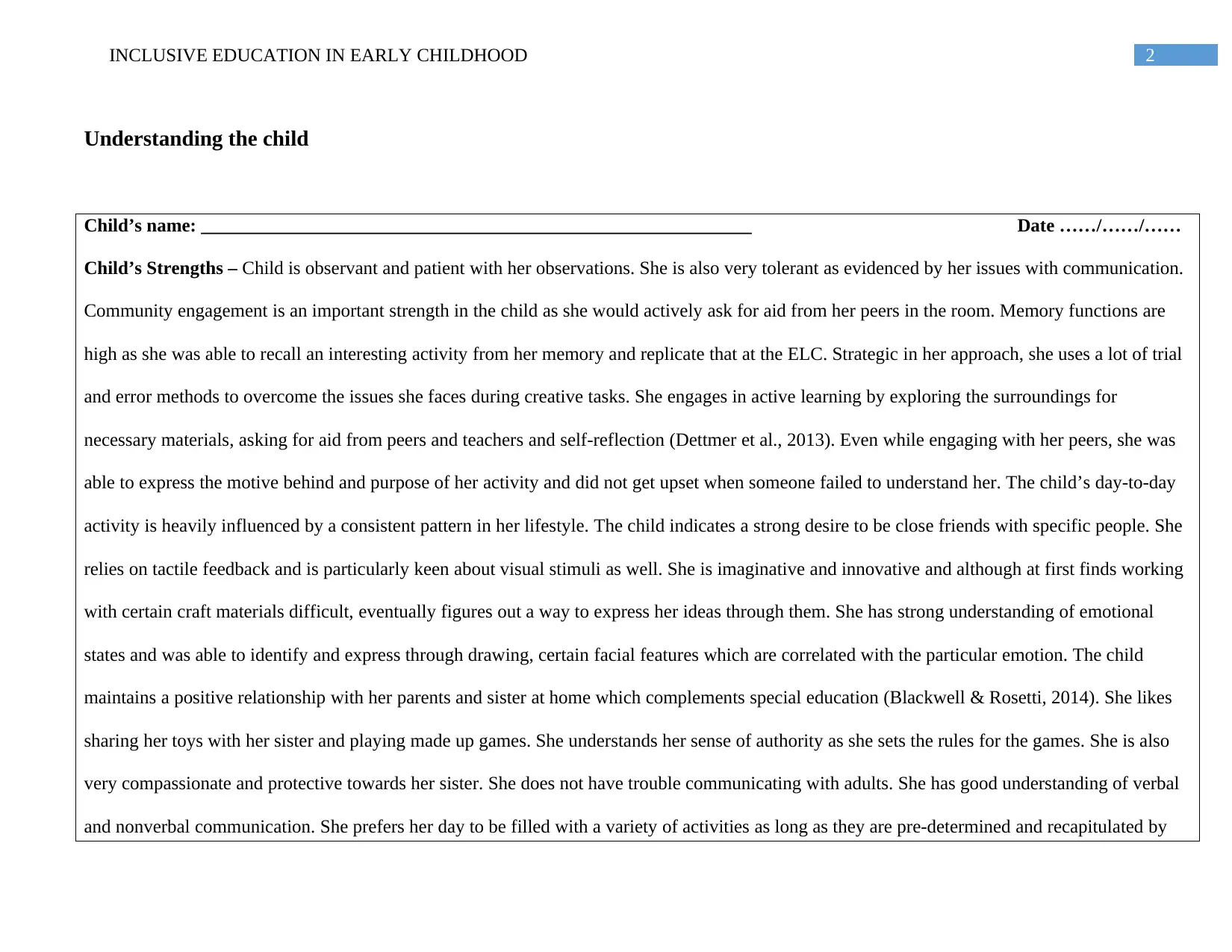
2INCLUSIVE EDUCATION IN EARLY CHILDHOOD
Understanding the child
Child’s name: ___________________________________________________________ Date ……/……/……
Child’s Strengths – Child is observant and patient with her observations. She is also very tolerant as evidenced by her issues with communication.
Community engagement is an important strength in the child as she would actively ask for aid from her peers in the room. Memory functions are
high as she was able to recall an interesting activity from her memory and replicate that at the ELC. Strategic in her approach, she uses a lot of trial
and error methods to overcome the issues she faces during creative tasks. She engages in active learning by exploring the surroundings for
necessary materials, asking for aid from peers and teachers and self-reflection (Dettmer et al., 2013). Even while engaging with her peers, she was
able to express the motive behind and purpose of her activity and did not get upset when someone failed to understand her. The child’s day-to-day
activity is heavily influenced by a consistent pattern in her lifestyle. The child indicates a strong desire to be close friends with specific people. She
relies on tactile feedback and is particularly keen about visual stimuli as well. She is imaginative and innovative and although at first finds working
with certain craft materials difficult, eventually figures out a way to express her ideas through them. She has strong understanding of emotional
states and was able to identify and express through drawing, certain facial features which are correlated with the particular emotion. The child
maintains a positive relationship with her parents and sister at home which complements special education (Blackwell & Rosetti, 2014). She likes
sharing her toys with her sister and playing made up games. She understands her sense of authority as she sets the rules for the games. She is also
very compassionate and protective towards her sister. She does not have trouble communicating with adults. She has good understanding of verbal
and nonverbal communication. She prefers her day to be filled with a variety of activities as long as they are pre-determined and recapitulated by
Understanding the child
Child’s name: ___________________________________________________________ Date ……/……/……
Child’s Strengths – Child is observant and patient with her observations. She is also very tolerant as evidenced by her issues with communication.
Community engagement is an important strength in the child as she would actively ask for aid from her peers in the room. Memory functions are
high as she was able to recall an interesting activity from her memory and replicate that at the ELC. Strategic in her approach, she uses a lot of trial
and error methods to overcome the issues she faces during creative tasks. She engages in active learning by exploring the surroundings for
necessary materials, asking for aid from peers and teachers and self-reflection (Dettmer et al., 2013). Even while engaging with her peers, she was
able to express the motive behind and purpose of her activity and did not get upset when someone failed to understand her. The child’s day-to-day
activity is heavily influenced by a consistent pattern in her lifestyle. The child indicates a strong desire to be close friends with specific people. She
relies on tactile feedback and is particularly keen about visual stimuli as well. She is imaginative and innovative and although at first finds working
with certain craft materials difficult, eventually figures out a way to express her ideas through them. She has strong understanding of emotional
states and was able to identify and express through drawing, certain facial features which are correlated with the particular emotion. The child
maintains a positive relationship with her parents and sister at home which complements special education (Blackwell & Rosetti, 2014). She likes
sharing her toys with her sister and playing made up games. She understands her sense of authority as she sets the rules for the games. She is also
very compassionate and protective towards her sister. She does not have trouble communicating with adults. She has good understanding of verbal
and nonverbal communication. She prefers her day to be filled with a variety of activities as long as they are pre-determined and recapitulated by
⊘ This is a preview!⊘
Do you want full access?
Subscribe today to unlock all pages.

Trusted by 1+ million students worldwide
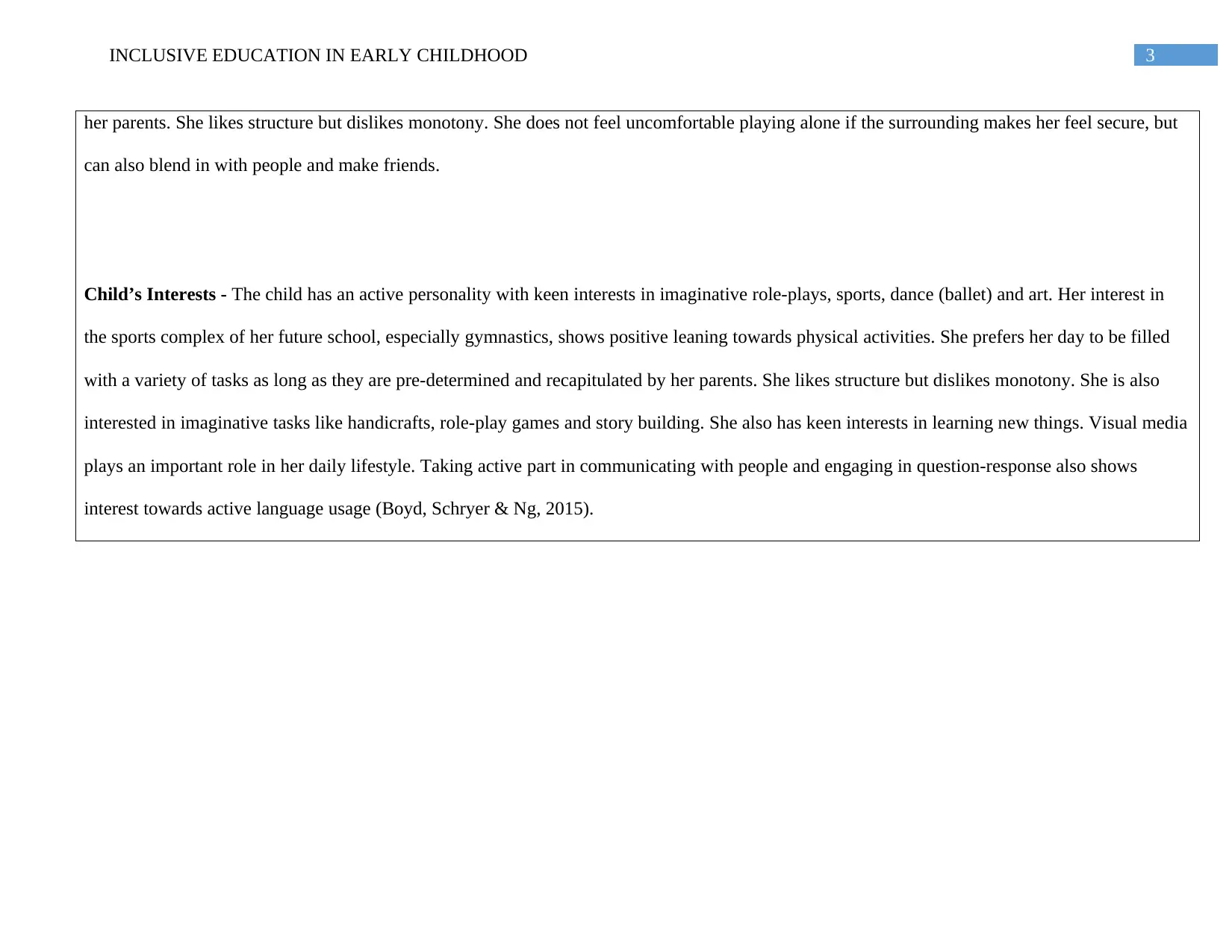
3INCLUSIVE EDUCATION IN EARLY CHILDHOOD
her parents. She likes structure but dislikes monotony. She does not feel uncomfortable playing alone if the surrounding makes her feel secure, but
can also blend in with people and make friends.
Child’s Interests - The child has an active personality with keen interests in imaginative role-plays, sports, dance (ballet) and art. Her interest in
the sports complex of her future school, especially gymnastics, shows positive leaning towards physical activities. She prefers her day to be filled
with a variety of tasks as long as they are pre-determined and recapitulated by her parents. She likes structure but dislikes monotony. She is also
interested in imaginative tasks like handicrafts, role-play games and story building. She also has keen interests in learning new things. Visual media
plays an important role in her daily lifestyle. Taking active part in communicating with people and engaging in question-response also shows
interest towards active language usage (Boyd, Schryer & Ng, 2015).
her parents. She likes structure but dislikes monotony. She does not feel uncomfortable playing alone if the surrounding makes her feel secure, but
can also blend in with people and make friends.
Child’s Interests - The child has an active personality with keen interests in imaginative role-plays, sports, dance (ballet) and art. Her interest in
the sports complex of her future school, especially gymnastics, shows positive leaning towards physical activities. She prefers her day to be filled
with a variety of tasks as long as they are pre-determined and recapitulated by her parents. She likes structure but dislikes monotony. She is also
interested in imaginative tasks like handicrafts, role-play games and story building. She also has keen interests in learning new things. Visual media
plays an important role in her daily lifestyle. Taking active part in communicating with people and engaging in question-response also shows
interest towards active language usage (Boyd, Schryer & Ng, 2015).
Paraphrase This Document
Need a fresh take? Get an instant paraphrase of this document with our AI Paraphraser
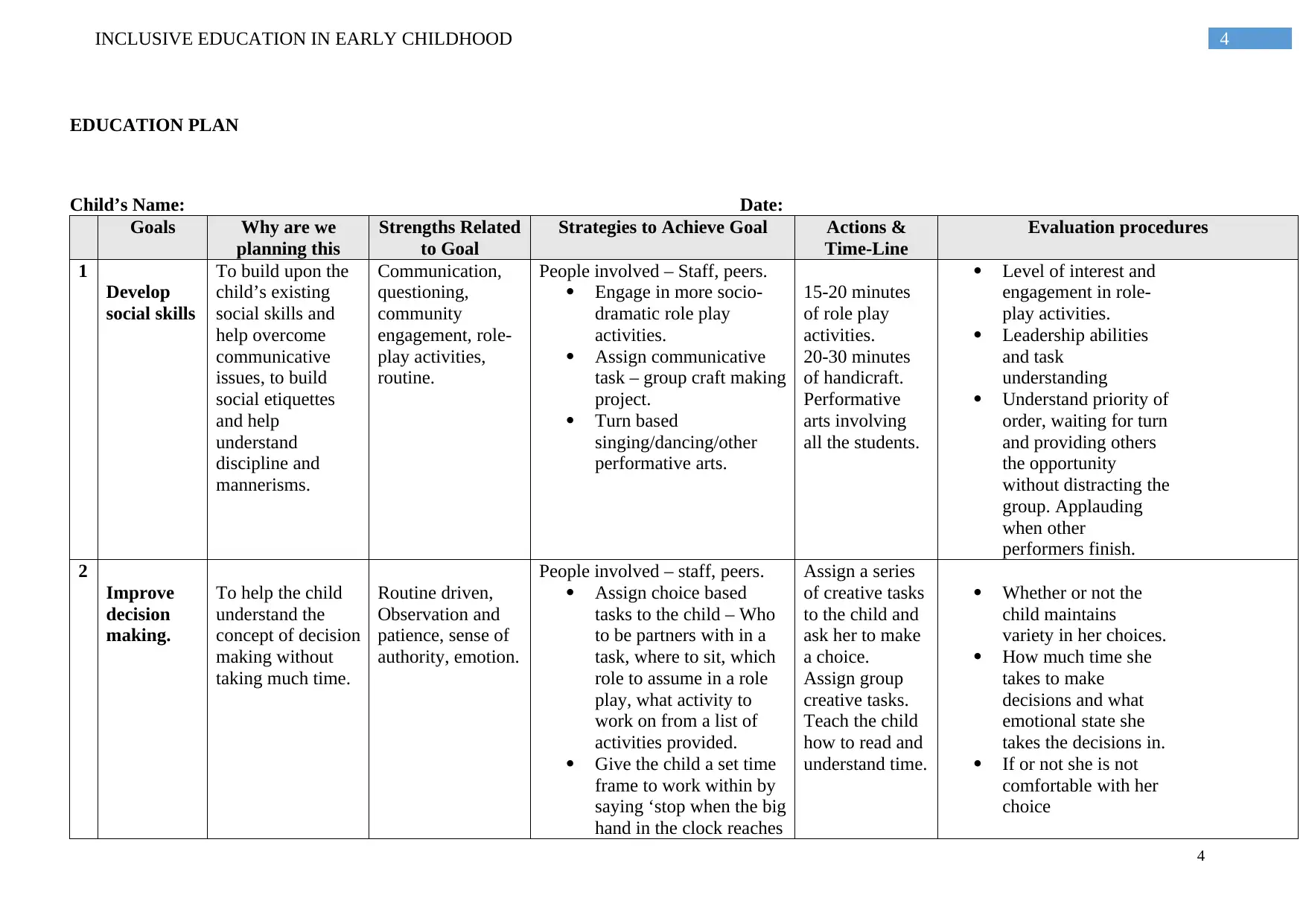
4INCLUSIVE EDUCATION IN EARLY CHILDHOOD
EDUCATION PLAN
Child’s Name: Date:
Goals Why are we
planning this
Strengths Related
to Goal
Strategies to Achieve Goal Actions &
Time-Line
Evaluation procedures
1
Develop
social skills
To build upon the
child’s existing
social skills and
help overcome
communicative
issues, to build
social etiquettes
and help
understand
discipline and
mannerisms.
Communication,
questioning,
community
engagement, role-
play activities,
routine.
People involved – Staff, peers.
Engage in more socio-
dramatic role play
activities.
Assign communicative
task – group craft making
project.
Turn based
singing/dancing/other
performative arts.
15-20 minutes
of role play
activities.
20-30 minutes
of handicraft.
Performative
arts involving
all the students.
Level of interest and
engagement in role-
play activities.
Leadership abilities
and task
understanding
Understand priority of
order, waiting for turn
and providing others
the opportunity
without distracting the
group. Applauding
when other
performers finish.
2
Improve
decision
making.
To help the child
understand the
concept of decision
making without
taking much time.
Routine driven,
Observation and
patience, sense of
authority, emotion.
People involved – staff, peers.
Assign choice based
tasks to the child – Who
to be partners with in a
task, where to sit, which
role to assume in a role
play, what activity to
work on from a list of
activities provided.
Give the child a set time
frame to work within by
saying ‘stop when the big
hand in the clock reaches
Assign a series
of creative tasks
to the child and
ask her to make
a choice.
Assign group
creative tasks.
Teach the child
how to read and
understand time.
Whether or not the
child maintains
variety in her choices.
How much time she
takes to make
decisions and what
emotional state she
takes the decisions in.
If or not she is not
comfortable with her
choice
4
EDUCATION PLAN
Child’s Name: Date:
Goals Why are we
planning this
Strengths Related
to Goal
Strategies to Achieve Goal Actions &
Time-Line
Evaluation procedures
1
Develop
social skills
To build upon the
child’s existing
social skills and
help overcome
communicative
issues, to build
social etiquettes
and help
understand
discipline and
mannerisms.
Communication,
questioning,
community
engagement, role-
play activities,
routine.
People involved – Staff, peers.
Engage in more socio-
dramatic role play
activities.
Assign communicative
task – group craft making
project.
Turn based
singing/dancing/other
performative arts.
15-20 minutes
of role play
activities.
20-30 minutes
of handicraft.
Performative
arts involving
all the students.
Level of interest and
engagement in role-
play activities.
Leadership abilities
and task
understanding
Understand priority of
order, waiting for turn
and providing others
the opportunity
without distracting the
group. Applauding
when other
performers finish.
2
Improve
decision
making.
To help the child
understand the
concept of decision
making without
taking much time.
Routine driven,
Observation and
patience, sense of
authority, emotion.
People involved – staff, peers.
Assign choice based
tasks to the child – Who
to be partners with in a
task, where to sit, which
role to assume in a role
play, what activity to
work on from a list of
activities provided.
Give the child a set time
frame to work within by
saying ‘stop when the big
hand in the clock reaches
Assign a series
of creative tasks
to the child and
ask her to make
a choice.
Assign group
creative tasks.
Teach the child
how to read and
understand time.
Whether or not the
child maintains
variety in her choices.
How much time she
takes to make
decisions and what
emotional state she
takes the decisions in.
If or not she is not
comfortable with her
choice
4
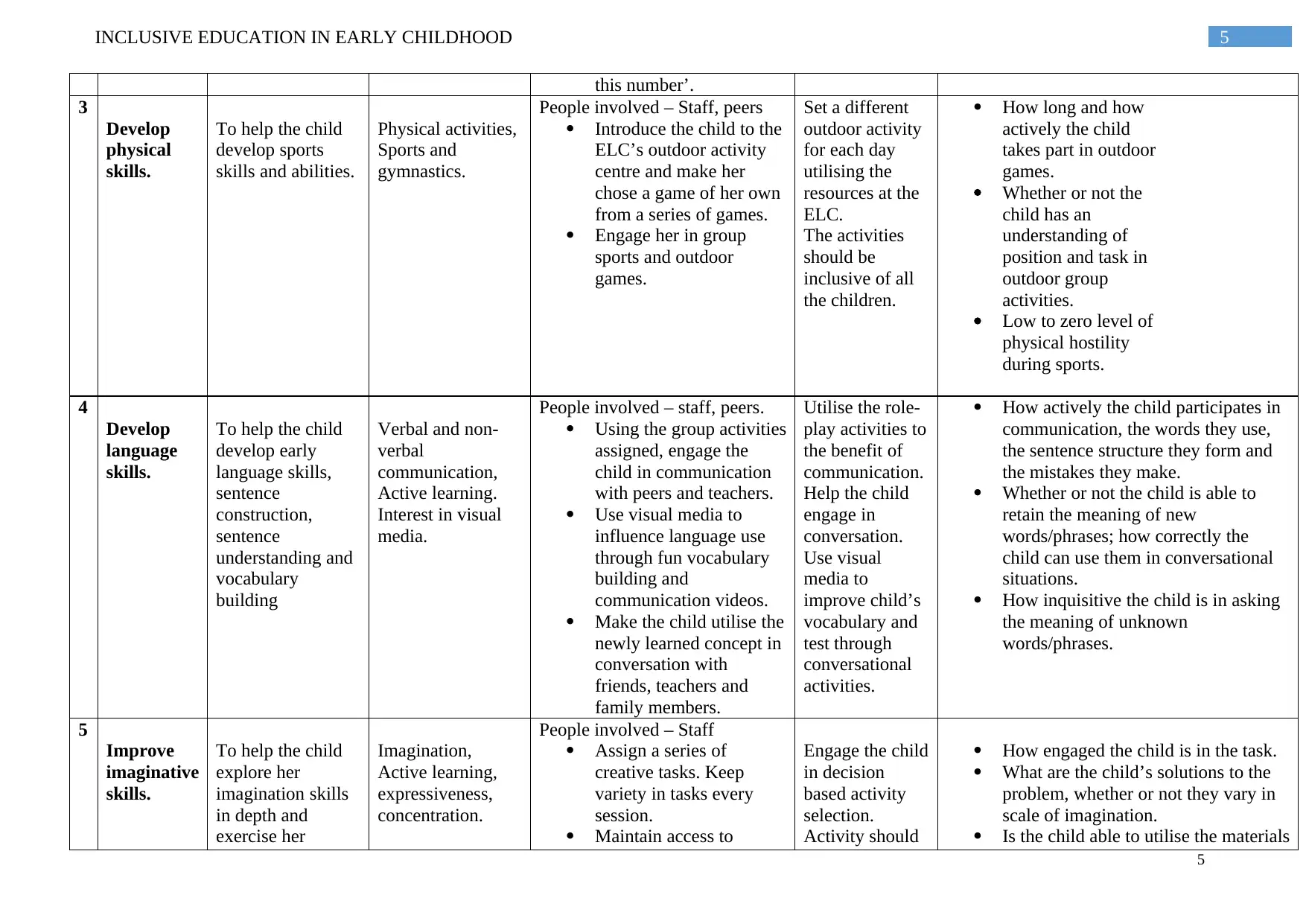
5INCLUSIVE EDUCATION IN EARLY CHILDHOOD
this number’.
3
Develop
physical
skills.
To help the child
develop sports
skills and abilities.
Physical activities,
Sports and
gymnastics.
People involved – Staff, peers
Introduce the child to the
ELC’s outdoor activity
centre and make her
chose a game of her own
from a series of games.
Engage her in group
sports and outdoor
games.
Set a different
outdoor activity
for each day
utilising the
resources at the
ELC.
The activities
should be
inclusive of all
the children.
How long and how
actively the child
takes part in outdoor
games.
Whether or not the
child has an
understanding of
position and task in
outdoor group
activities.
Low to zero level of
physical hostility
during sports.
4
Develop
language
skills.
To help the child
develop early
language skills,
sentence
construction,
sentence
understanding and
vocabulary
building
Verbal and non-
verbal
communication,
Active learning.
Interest in visual
media.
People involved – staff, peers.
Using the group activities
assigned, engage the
child in communication
with peers and teachers.
Use visual media to
influence language use
through fun vocabulary
building and
communication videos.
Make the child utilise the
newly learned concept in
conversation with
friends, teachers and
family members.
Utilise the role-
play activities to
the benefit of
communication.
Help the child
engage in
conversation.
Use visual
media to
improve child’s
vocabulary and
test through
conversational
activities.
How actively the child participates in
communication, the words they use,
the sentence structure they form and
the mistakes they make.
Whether or not the child is able to
retain the meaning of new
words/phrases; how correctly the
child can use them in conversational
situations.
How inquisitive the child is in asking
the meaning of unknown
words/phrases.
5
Improve
imaginative
skills.
To help the child
explore her
imagination skills
in depth and
exercise her
Imagination,
Active learning,
expressiveness,
concentration.
People involved – Staff
Assign a series of
creative tasks. Keep
variety in tasks every
session.
Maintain access to
Engage the child
in decision
based activity
selection.
Activity should
How engaged the child is in the task.
What are the child’s solutions to the
problem, whether or not they vary in
scale of imagination.
Is the child able to utilise the materials
5
this number’.
3
Develop
physical
skills.
To help the child
develop sports
skills and abilities.
Physical activities,
Sports and
gymnastics.
People involved – Staff, peers
Introduce the child to the
ELC’s outdoor activity
centre and make her
chose a game of her own
from a series of games.
Engage her in group
sports and outdoor
games.
Set a different
outdoor activity
for each day
utilising the
resources at the
ELC.
The activities
should be
inclusive of all
the children.
How long and how
actively the child
takes part in outdoor
games.
Whether or not the
child has an
understanding of
position and task in
outdoor group
activities.
Low to zero level of
physical hostility
during sports.
4
Develop
language
skills.
To help the child
develop early
language skills,
sentence
construction,
sentence
understanding and
vocabulary
building
Verbal and non-
verbal
communication,
Active learning.
Interest in visual
media.
People involved – staff, peers.
Using the group activities
assigned, engage the
child in communication
with peers and teachers.
Use visual media to
influence language use
through fun vocabulary
building and
communication videos.
Make the child utilise the
newly learned concept in
conversation with
friends, teachers and
family members.
Utilise the role-
play activities to
the benefit of
communication.
Help the child
engage in
conversation.
Use visual
media to
improve child’s
vocabulary and
test through
conversational
activities.
How actively the child participates in
communication, the words they use,
the sentence structure they form and
the mistakes they make.
Whether or not the child is able to
retain the meaning of new
words/phrases; how correctly the
child can use them in conversational
situations.
How inquisitive the child is in asking
the meaning of unknown
words/phrases.
5
Improve
imaginative
skills.
To help the child
explore her
imagination skills
in depth and
exercise her
Imagination,
Active learning,
expressiveness,
concentration.
People involved – Staff
Assign a series of
creative tasks. Keep
variety in tasks every
session.
Maintain access to
Engage the child
in decision
based activity
selection.
Activity should
How engaged the child is in the task.
What are the child’s solutions to the
problem, whether or not they vary in
scale of imagination.
Is the child able to utilise the materials
5
⊘ This is a preview!⊘
Do you want full access?
Subscribe today to unlock all pages.

Trusted by 1+ million students worldwide

6INCLUSIVE EDUCATION IN EARLY CHILDHOOD
creativity through
fun educational
practices.
required materials. Let
the child work out
techniques but help
whenever required.
be creative in
nature to explore
the child’s
prime area of
strength.
Teach the child
how to use the
materials to
build something
out of
imagination.
properly or at least understand that a
certain material is needed to be used.
How frequently the child asks for help
from the teacher.
Review Date:...........................................
Child’s Name: Date:
Observation (what happened)?
The child concerned has auditory processing issues. However that has not proved to be a deterrent for her other functions. She is physically active
with keen interest in sports. She is observant, patient and meticulous in dealing with activities as well as friends. She maintains positive
relationships with friends and family. She understands the use of non-verbal cues to imply a message. She has high imagination skills and resorts
to active learning to arrive at solutions for problems. She understands emotions and their physical manifestations and can pictorially depict them.
Her weaknesses include dependency on a systematic lifestyle and inability to deal with unpredictable situations. She likes to be the centre of
attention and can often resort to violent means if desired attention is not obtained.
6
creativity through
fun educational
practices.
required materials. Let
the child work out
techniques but help
whenever required.
be creative in
nature to explore
the child’s
prime area of
strength.
Teach the child
how to use the
materials to
build something
out of
imagination.
properly or at least understand that a
certain material is needed to be used.
How frequently the child asks for help
from the teacher.
Review Date:...........................................
Child’s Name: Date:
Observation (what happened)?
The child concerned has auditory processing issues. However that has not proved to be a deterrent for her other functions. She is physically active
with keen interest in sports. She is observant, patient and meticulous in dealing with activities as well as friends. She maintains positive
relationships with friends and family. She understands the use of non-verbal cues to imply a message. She has high imagination skills and resorts
to active learning to arrive at solutions for problems. She understands emotions and their physical manifestations and can pictorially depict them.
Her weaknesses include dependency on a systematic lifestyle and inability to deal with unpredictable situations. She likes to be the centre of
attention and can often resort to violent means if desired attention is not obtained.
6
Paraphrase This Document
Need a fresh take? Get an instant paraphrase of this document with our AI Paraphraser
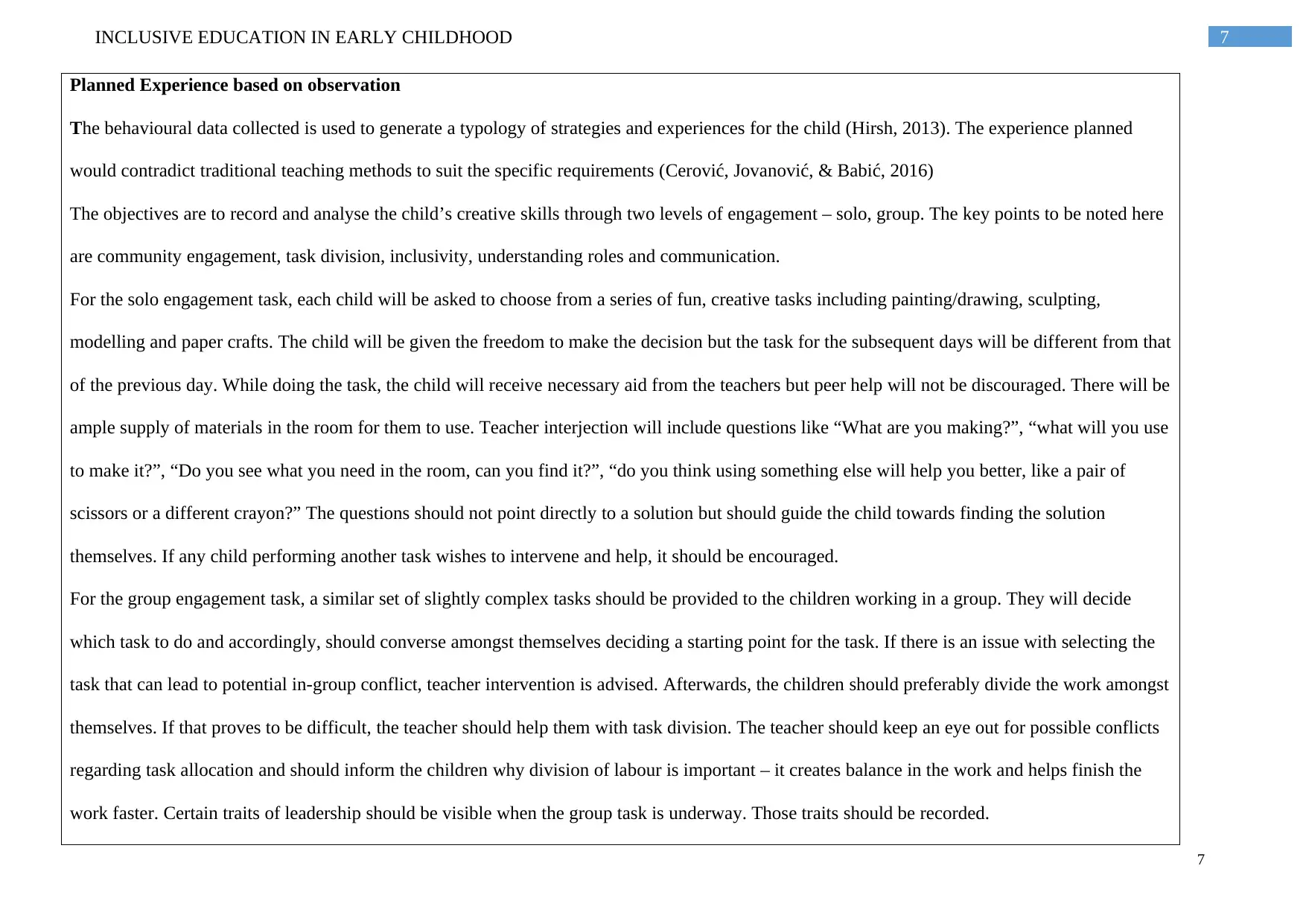
7INCLUSIVE EDUCATION IN EARLY CHILDHOOD
Planned Experience based on observation
The behavioural data collected is used to generate a typology of strategies and experiences for the child (Hirsh, 2013). The experience planned
would contradict traditional teaching methods to suit the specific requirements (Cerović, Jovanović, & Babić, 2016)
The objectives are to record and analyse the child’s creative skills through two levels of engagement – solo, group. The key points to be noted here
are community engagement, task division, inclusivity, understanding roles and communication.
For the solo engagement task, each child will be asked to choose from a series of fun, creative tasks including painting/drawing, sculpting,
modelling and paper crafts. The child will be given the freedom to make the decision but the task for the subsequent days will be different from that
of the previous day. While doing the task, the child will receive necessary aid from the teachers but peer help will not be discouraged. There will be
ample supply of materials in the room for them to use. Teacher interjection will include questions like “What are you making?”, “what will you use
to make it?”, “Do you see what you need in the room, can you find it?”, “do you think using something else will help you better, like a pair of
scissors or a different crayon?” The questions should not point directly to a solution but should guide the child towards finding the solution
themselves. If any child performing another task wishes to intervene and help, it should be encouraged.
For the group engagement task, a similar set of slightly complex tasks should be provided to the children working in a group. They will decide
which task to do and accordingly, should converse amongst themselves deciding a starting point for the task. If there is an issue with selecting the
task that can lead to potential in-group conflict, teacher intervention is advised. Afterwards, the children should preferably divide the work amongst
themselves. If that proves to be difficult, the teacher should help them with task division. The teacher should keep an eye out for possible conflicts
regarding task allocation and should inform the children why division of labour is important – it creates balance in the work and helps finish the
work faster. Certain traits of leadership should be visible when the group task is underway. Those traits should be recorded.
7
Planned Experience based on observation
The behavioural data collected is used to generate a typology of strategies and experiences for the child (Hirsh, 2013). The experience planned
would contradict traditional teaching methods to suit the specific requirements (Cerović, Jovanović, & Babić, 2016)
The objectives are to record and analyse the child’s creative skills through two levels of engagement – solo, group. The key points to be noted here
are community engagement, task division, inclusivity, understanding roles and communication.
For the solo engagement task, each child will be asked to choose from a series of fun, creative tasks including painting/drawing, sculpting,
modelling and paper crafts. The child will be given the freedom to make the decision but the task for the subsequent days will be different from that
of the previous day. While doing the task, the child will receive necessary aid from the teachers but peer help will not be discouraged. There will be
ample supply of materials in the room for them to use. Teacher interjection will include questions like “What are you making?”, “what will you use
to make it?”, “Do you see what you need in the room, can you find it?”, “do you think using something else will help you better, like a pair of
scissors or a different crayon?” The questions should not point directly to a solution but should guide the child towards finding the solution
themselves. If any child performing another task wishes to intervene and help, it should be encouraged.
For the group engagement task, a similar set of slightly complex tasks should be provided to the children working in a group. They will decide
which task to do and accordingly, should converse amongst themselves deciding a starting point for the task. If there is an issue with selecting the
task that can lead to potential in-group conflict, teacher intervention is advised. Afterwards, the children should preferably divide the work amongst
themselves. If that proves to be difficult, the teacher should help them with task division. The teacher should keep an eye out for possible conflicts
regarding task allocation and should inform the children why division of labour is important – it creates balance in the work and helps finish the
work faster. Certain traits of leadership should be visible when the group task is underway. Those traits should be recorded.
7

8INCLUSIVE EDUCATION IN EARLY CHILDHOOD
After the activity, the children should be made to engage in an interactive role-play activity where they showcase their creation and use them in the
narrative.
Evaluation (what happened?)
Evaluation should be done keeping in mind the primary strength and interest of the child concerned. While evaluating the experience, the following
points should be given importance –
1. How much time the child takes in making the decision.
2. If the child is able to bring in variety in her decisions? If not, change the type of tasks accordingly.
3. Is the child taking longer than necessary/is the child facing problems with the task?
4. If the child is facing problems, is she able to communicate that to the teacher or ask for help from peers?
5. Is the child able to help her friends in their tasks as well?
6. Is the child able to create a narrative for her craftwork and adjust well with the narratives of other children?
7. In group, how engaged the child is with the task.
8. Whether or not, in the group task, the child is showing traits of leadership. Those traits would include guiding others in the team to do
specific works or taking responsibility for the work she is supposed to do.
9. If the child engages in conflict or is able to resolve conflict in the team. With regards to resolving conflict, it should also be noted whether
the child asks for teacher interjection.
10. How the team dynamics function in contact with the other teams working on similar tasks. If they are able to maintain cordial behaviour
8
After the activity, the children should be made to engage in an interactive role-play activity where they showcase their creation and use them in the
narrative.
Evaluation (what happened?)
Evaluation should be done keeping in mind the primary strength and interest of the child concerned. While evaluating the experience, the following
points should be given importance –
1. How much time the child takes in making the decision.
2. If the child is able to bring in variety in her decisions? If not, change the type of tasks accordingly.
3. Is the child taking longer than necessary/is the child facing problems with the task?
4. If the child is facing problems, is she able to communicate that to the teacher or ask for help from peers?
5. Is the child able to help her friends in their tasks as well?
6. Is the child able to create a narrative for her craftwork and adjust well with the narratives of other children?
7. In group, how engaged the child is with the task.
8. Whether or not, in the group task, the child is showing traits of leadership. Those traits would include guiding others in the team to do
specific works or taking responsibility for the work she is supposed to do.
9. If the child engages in conflict or is able to resolve conflict in the team. With regards to resolving conflict, it should also be noted whether
the child asks for teacher interjection.
10. How the team dynamics function in contact with the other teams working on similar tasks. If they are able to maintain cordial behaviour
8
⊘ This is a preview!⊘
Do you want full access?
Subscribe today to unlock all pages.

Trusted by 1+ million students worldwide
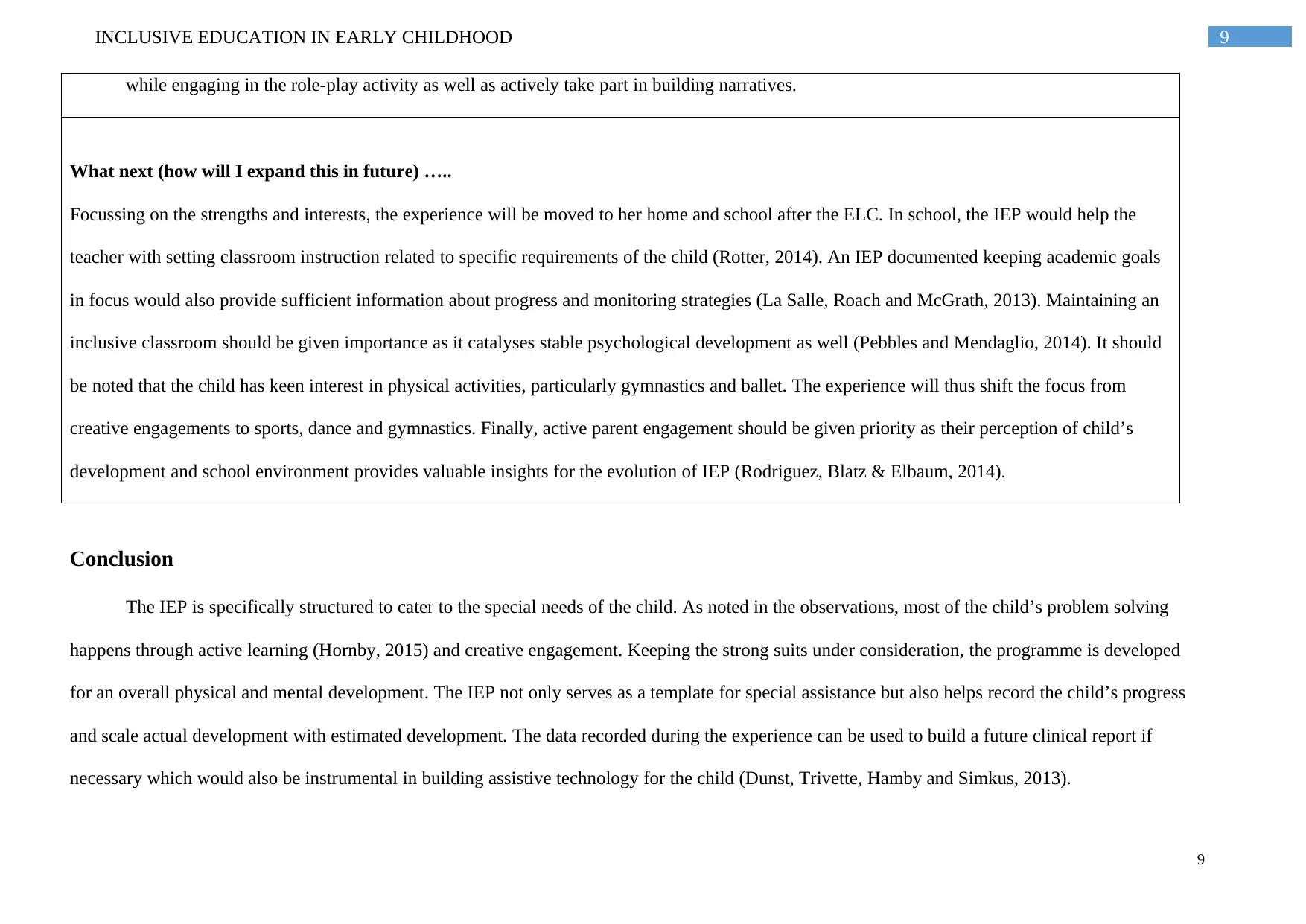
9INCLUSIVE EDUCATION IN EARLY CHILDHOOD
while engaging in the role-play activity as well as actively take part in building narratives.
What next (how will I expand this in future) …..
Focussing on the strengths and interests, the experience will be moved to her home and school after the ELC. In school, the IEP would help the
teacher with setting classroom instruction related to specific requirements of the child (Rotter, 2014). An IEP documented keeping academic goals
in focus would also provide sufficient information about progress and monitoring strategies (La Salle, Roach and McGrath, 2013). Maintaining an
inclusive classroom should be given importance as it catalyses stable psychological development as well (Pebbles and Mendaglio, 2014). It should
be noted that the child has keen interest in physical activities, particularly gymnastics and ballet. The experience will thus shift the focus from
creative engagements to sports, dance and gymnastics. Finally, active parent engagement should be given priority as their perception of child’s
development and school environment provides valuable insights for the evolution of IEP (Rodriguez, Blatz & Elbaum, 2014).
Conclusion
The IEP is specifically structured to cater to the special needs of the child. As noted in the observations, most of the child’s problem solving
happens through active learning (Hornby, 2015) and creative engagement. Keeping the strong suits under consideration, the programme is developed
for an overall physical and mental development. The IEP not only serves as a template for special assistance but also helps record the child’s progress
and scale actual development with estimated development. The data recorded during the experience can be used to build a future clinical report if
necessary which would also be instrumental in building assistive technology for the child (Dunst, Trivette, Hamby and Simkus, 2013).
9
while engaging in the role-play activity as well as actively take part in building narratives.
What next (how will I expand this in future) …..
Focussing on the strengths and interests, the experience will be moved to her home and school after the ELC. In school, the IEP would help the
teacher with setting classroom instruction related to specific requirements of the child (Rotter, 2014). An IEP documented keeping academic goals
in focus would also provide sufficient information about progress and monitoring strategies (La Salle, Roach and McGrath, 2013). Maintaining an
inclusive classroom should be given importance as it catalyses stable psychological development as well (Pebbles and Mendaglio, 2014). It should
be noted that the child has keen interest in physical activities, particularly gymnastics and ballet. The experience will thus shift the focus from
creative engagements to sports, dance and gymnastics. Finally, active parent engagement should be given priority as their perception of child’s
development and school environment provides valuable insights for the evolution of IEP (Rodriguez, Blatz & Elbaum, 2014).
Conclusion
The IEP is specifically structured to cater to the special needs of the child. As noted in the observations, most of the child’s problem solving
happens through active learning (Hornby, 2015) and creative engagement. Keeping the strong suits under consideration, the programme is developed
for an overall physical and mental development. The IEP not only serves as a template for special assistance but also helps record the child’s progress
and scale actual development with estimated development. The data recorded during the experience can be used to build a future clinical report if
necessary which would also be instrumental in building assistive technology for the child (Dunst, Trivette, Hamby and Simkus, 2013).
9
Paraphrase This Document
Need a fresh take? Get an instant paraphrase of this document with our AI Paraphraser
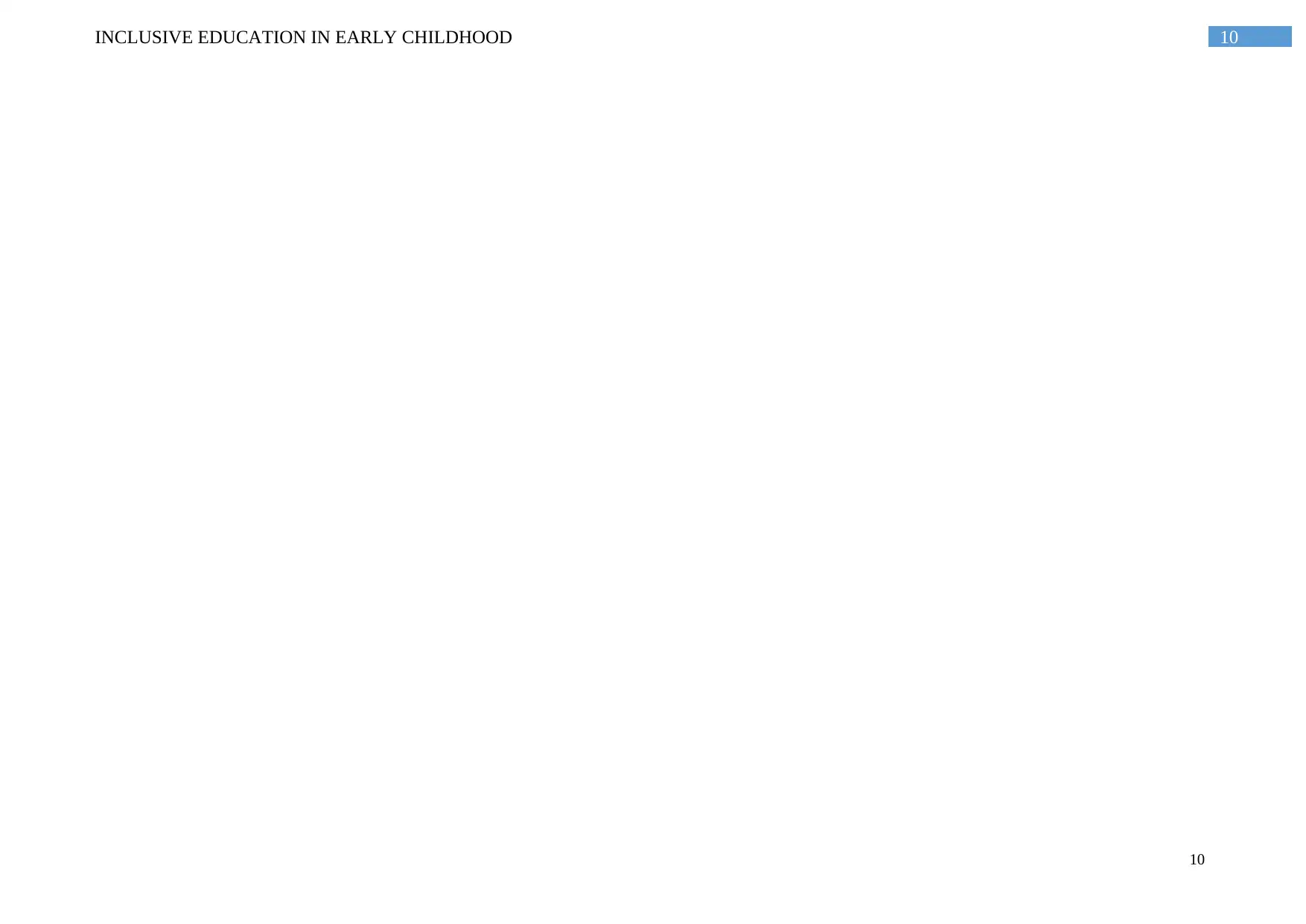
10INCLUSIVE EDUCATION IN EARLY CHILDHOOD
10
10
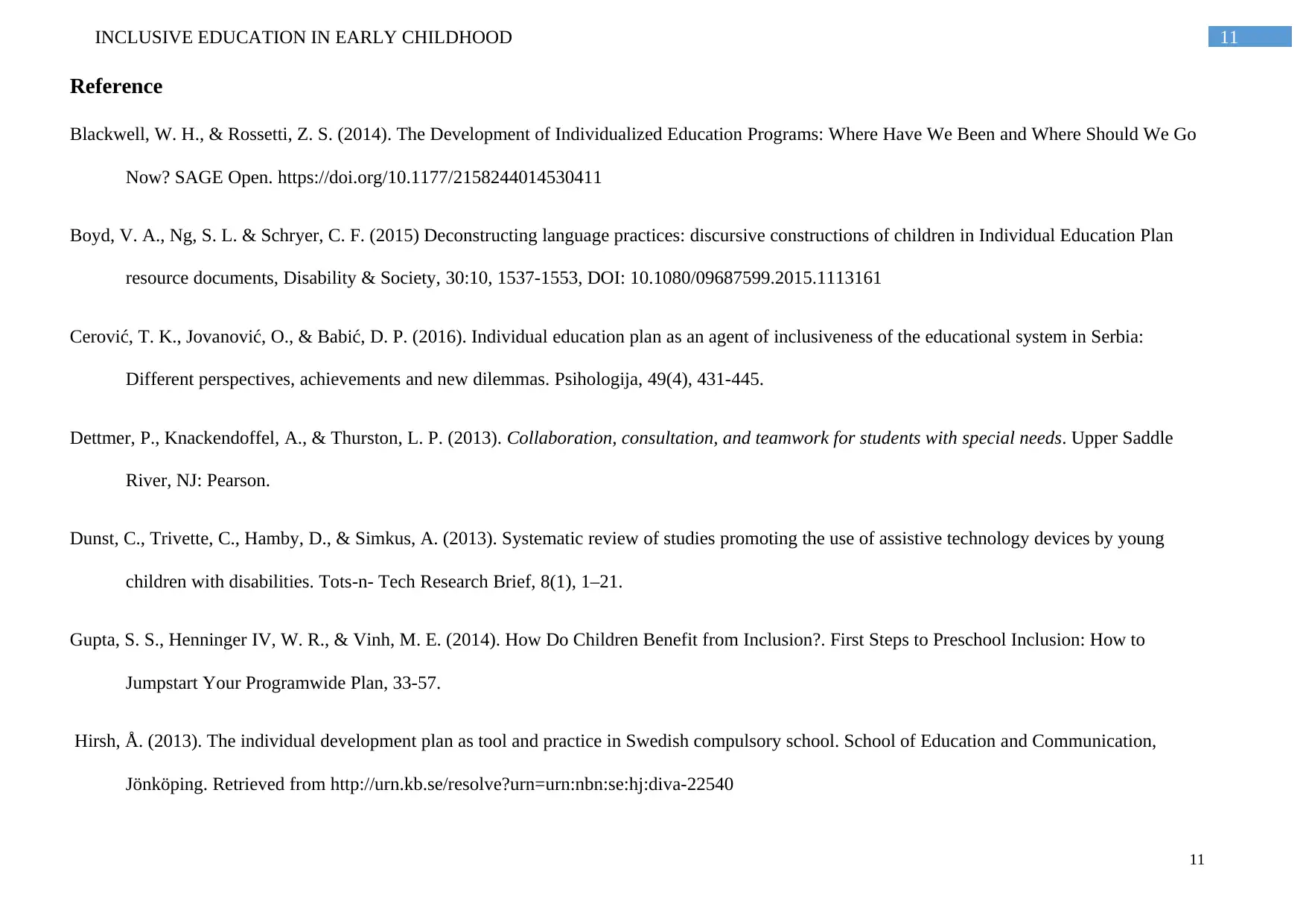
11INCLUSIVE EDUCATION IN EARLY CHILDHOOD
Reference
Blackwell, W. H., & Rossetti, Z. S. (2014). The Development of Individualized Education Programs: Where Have We Been and Where Should We Go
Now? SAGE Open. https://doi.org/10.1177/2158244014530411
Boyd, V. A., Ng, S. L. & Schryer, C. F. (2015) Deconstructing language practices: discursive constructions of children in Individual Education Plan
resource documents, Disability & Society, 30:10, 1537-1553, DOI: 10.1080/09687599.2015.1113161
Cerović, T. K., Jovanović, O., & Babić, D. P. (2016). Individual education plan as an agent of inclusiveness of the educational system in Serbia:
Different perspectives, achievements and new dilemmas. Psihologija, 49(4), 431-445.
Dettmer, P., Knackendoffel, A., & Thurston, L. P. (2013). Collaboration, consultation, and teamwork for students with special needs. Upper Saddle
River, NJ: Pearson.
Dunst, C., Trivette, C., Hamby, D., & Simkus, A. (2013). Systematic review of studies promoting the use of assistive technology devices by young
children with disabilities. Tots-n- Tech Research Brief, 8(1), 1–21.
Gupta, S. S., Henninger IV, W. R., & Vinh, M. E. (2014). How Do Children Benefit from Inclusion?. First Steps to Preschool Inclusion: How to
Jumpstart Your Programwide Plan, 33-57.
Hirsh, Å. (2013). The individual development plan as tool and practice in Swedish compulsory school. School of Education and Communication,
Jönköping. Retrieved from http://urn.kb.se/resolve?urn=urn:nbn:se:hj:diva-22540
11
Reference
Blackwell, W. H., & Rossetti, Z. S. (2014). The Development of Individualized Education Programs: Where Have We Been and Where Should We Go
Now? SAGE Open. https://doi.org/10.1177/2158244014530411
Boyd, V. A., Ng, S. L. & Schryer, C. F. (2015) Deconstructing language practices: discursive constructions of children in Individual Education Plan
resource documents, Disability & Society, 30:10, 1537-1553, DOI: 10.1080/09687599.2015.1113161
Cerović, T. K., Jovanović, O., & Babić, D. P. (2016). Individual education plan as an agent of inclusiveness of the educational system in Serbia:
Different perspectives, achievements and new dilemmas. Psihologija, 49(4), 431-445.
Dettmer, P., Knackendoffel, A., & Thurston, L. P. (2013). Collaboration, consultation, and teamwork for students with special needs. Upper Saddle
River, NJ: Pearson.
Dunst, C., Trivette, C., Hamby, D., & Simkus, A. (2013). Systematic review of studies promoting the use of assistive technology devices by young
children with disabilities. Tots-n- Tech Research Brief, 8(1), 1–21.
Gupta, S. S., Henninger IV, W. R., & Vinh, M. E. (2014). How Do Children Benefit from Inclusion?. First Steps to Preschool Inclusion: How to
Jumpstart Your Programwide Plan, 33-57.
Hirsh, Å. (2013). The individual development plan as tool and practice in Swedish compulsory school. School of Education and Communication,
Jönköping. Retrieved from http://urn.kb.se/resolve?urn=urn:nbn:se:hj:diva-22540
11
⊘ This is a preview!⊘
Do you want full access?
Subscribe today to unlock all pages.

Trusted by 1+ million students worldwide
1 out of 13
Related Documents
Your All-in-One AI-Powered Toolkit for Academic Success.
+13062052269
info@desklib.com
Available 24*7 on WhatsApp / Email
![[object Object]](/_next/static/media/star-bottom.7253800d.svg)
Unlock your academic potential
Copyright © 2020–2025 A2Z Services. All Rights Reserved. Developed and managed by ZUCOL.




